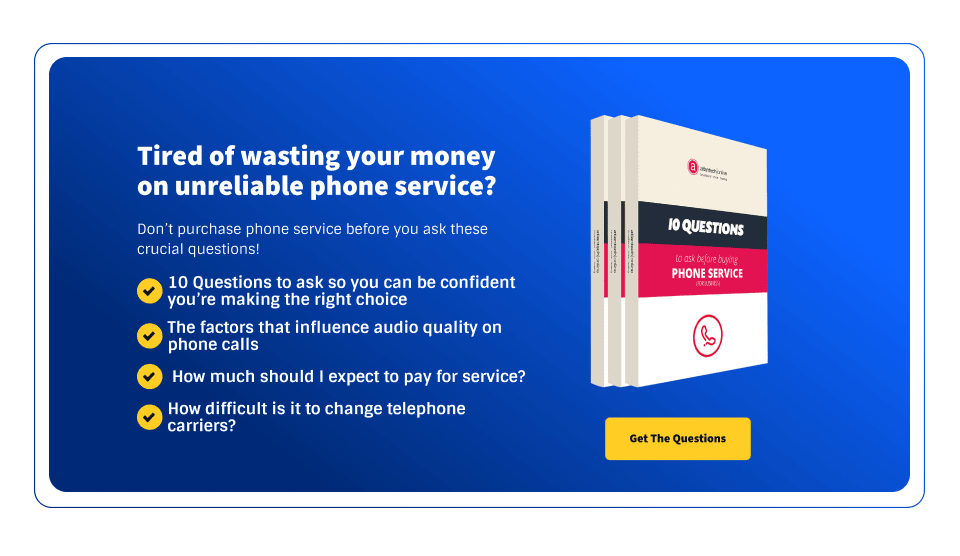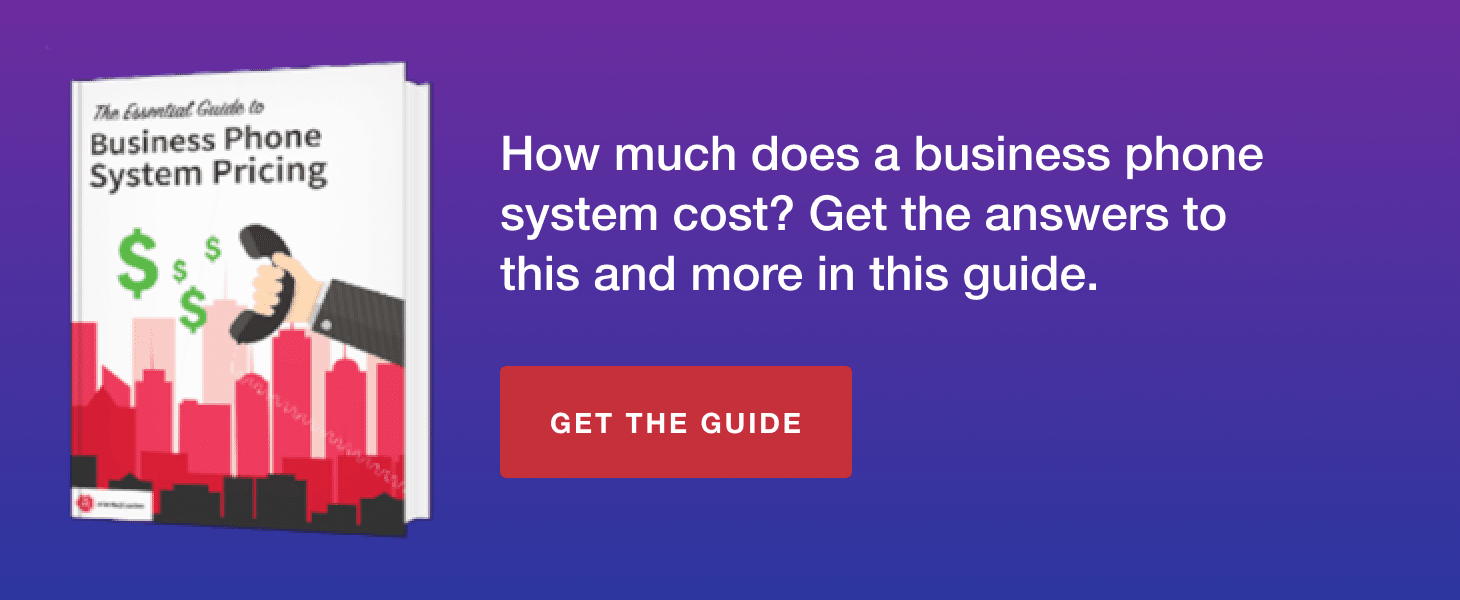Small Business Phone System Cost: Calculations and Considerations for 2022

Though email, instant messaging, tweeting, and other social media networks have been adopted for business purposes, telephone calls remain the most personal and often convenient method of communication, especially now that a large portion of the population is on many days working from home.
The bottom line is that investing in quality voice phone service is still mandatory for modern businesses.
While necessary, telephony can represent a significant financial investment for small businesses. Whether you're looking for an initial installation or replacement, knowing the average company replaces their phone system every seven years is useful. The right selection can meet your needs for years to come.
Eight essential considerations for calculating telephone costs for small businesses:
- The Number of Users
- Features and Functionality Required
- Number of Physical Sites
- Phone Model
- Layers of Redundancy
- Type of System Selected
- Required Training
- Annual Maintenance Requirements
Influential Factors in Calculating Telephone Costs for Small Business
Business phone system needs are in a constant state of flux, especially now. Ignoring the evolution of the workplace after a worldwide pandemic is probably not wise. Companies got by with phones on each desk just a few years ago. With an increasingly remote and hybrid workforce, employees aren't coming into the office each day. As a result, a standard desk phone no longer serves the business needs of most organizations.
Still, even in a hybrid work environment with rampant telecommuting included, some common factors impact business phone pricing:
1. The Number of Users
How many phone lines (or call paths) does your company require? Analyzing your business's user needs can be focused on the total phone lines required.
Certain components of your business, such as reception, accounting, or the mailroom, may only need a single line for multiple employees.
When performing user planning, it's important to understand your client's need to reach various areas of your company and employees' possible need to communicate internally.
2. Features and Functionality Required
Today, there are many exciting options for companies who realize that the world has gone mobile. At Atlantech, our clients can build their own private wireless network connected seamlessly with their Unified Communications platform.
For companies who want to empower their employees with wireless mobility without the expense of handsets, we also offer what is called an eSim, turning every employee's personal cell phone into a fully-integrated business line that operates natively in either the iOS or Android platform.
Basic phone service packages allow businesses to place and receive local and long-distance calls. However, many companies find that choosing add-on phone services can significantly improve productivity and collaboration.
Commonly requested add-on services can include: conferencing, mobility, call center, Interactive Voice Response (IVR), enhanced 911 services, and integration with CRM, ERP, or other internal systems.
While these add-on services can significantly increase client and employee satisfaction with your new phone system, they will increase your costs above more basic phone service packages. Depending on your vendor, these services could be bundled for cost savings.
As a result of the global pandemic, Microsoft Teams usage increased to over 150 million users. Making it available as a softphone has become one of the most common add-on service options of 2020.
3. Number of Physical Sites
Is your company concentrated at a single location, or do you have multiple locations that require phone lines or call appearances?
A company with 20 users at a single site’s installation costs will ultimately be lower than the cost of installing phone lines at multiple sites. Each location that requires installation can increase the final cost of your small business phone system.
4. Phone Model
It may surprise some small business owners and information technology specialists, but not all business phone models are the same. Costs can vary drastically depending on selecting a generic phone model, a medium-range name brand model, or a top-of-the-line name-brand model.
Phone features that may or may not be included, depending on your phone model, can include:
- 3-Way Calling
- Intercom
- Automatic Callback
- Call Transfer
- Call Forwarding
- Call Hold
- Speed Dial
- Call Waiting
- Inside/Outside Ringing
Depending on your small business structure, some or all of your business users may require phones with many optional features fully included. I am seeing many of our customers electing to use soft phones, exclusively. But, depending on your user base, phone handsets are still in demand.
5. Layers of Redundancy
Redundancy, in technical terms, can be used interchangeably with the business euphemism of having “Plan B.” Your company’s redundancy needs can vary according to how critical voice services are to your business’s operations. If you’re completely unable to function without voice services, you may require redundancy that can quickly restore your phone service in the event of an outage with minimal interruptions.
6. Type of System Selected
The phone system you select can affect the costs of your hardware, maintenance, and installation. It can also dictate the pricing of any add-on services you’re hoping to include.
Almost all businesses opt for Voice over IP (VoIP) services, which can save significant money over traditional phone systems while maintaining the high voice quality your customers expect. Whether you ultimately select traditional voice providers or VoIP, your system selection should include attention to the following factors:
- Cost
- Level of Service
- Reliability/Uptime
- Vendor Customer Support
- Mobility
- Calling Features
- Integration with CRM, ERP, or other internal systems
7. Required Training
All employees who will be using phone lines on a regular or occasional basis will require training on effectively operating these new technologies.
Training costs can vary according to your number of employees and sites, but you may be able to reduce training costs by managing this process internally. Regardless, it’s critical to account for this factor when budgeting for a new phone system.
8. Annual Maintenance Requirements
The annual maintenance costs of your phone system can vary according to several factors, including your internal IT resources. If your internal talent is qualified to perform basic troubleshooting and training, your need for external maintenance assistance could be diminished.
Provider offerings can vary, but many small businesses opt for maintenance assistance on an annual (contract) or as-needed basis. Contracts typically cover a dedicated amount of hours on-site each year and may include some necessary replacements or modifications to equipment.
Total Estimated Telephone Costs for Small Business
The following information gives a ballpark view of how much a basic business phone service would cost. However, due to the rapidly changing business structure in the world and the evolving needs to facilitate those changes, there is no cookie-cutter pricing anymore.
It’s best to speak with a pro who can ascertain your needs and make recommendations based on them. Then, the pricing estimate will be based on what you really need. That way, you don’t end up going cookie cutter and regretting the lack of functionality or paying a ton of money for things you don’t use.
Depending on the number of add-on services you select, a low-end system may cost your company approximately $200 per handset. A name-brand system will have pricing in the range of $400-$600 per handset. A fully-loaded, top-of-the-line name brand system could equate to approximately $1,000 per handset.
|
|
Low-End System |
Mid-Range System |
High-End System |
|
Per Handset |
$200 |
$400-600 |
$1,000 |
Per handset is a convenient measure of estimated costs. If you know your company will need 20 phones in your office, your handset needs are 20. A high-end system would cost approximately $20,000, which is calculated by multiplying the estimated cost by the total number of handsets:
20 * $1,000 = $20,000
While a phone system can represent a significant financial commitment for small businesses, annual maintenance costs and training will be far lower than the initial installation.
This is one reason why many of my customers are opting out of the handset model and going with soft phones. You can also lease handsets rather than purchase them, further driving down capital expense.
Review our free resource, 10 Questions to Ask Before You Buy Phone Service for Your Business, to ensure you’re prepared to make the best decision possible for your business.



